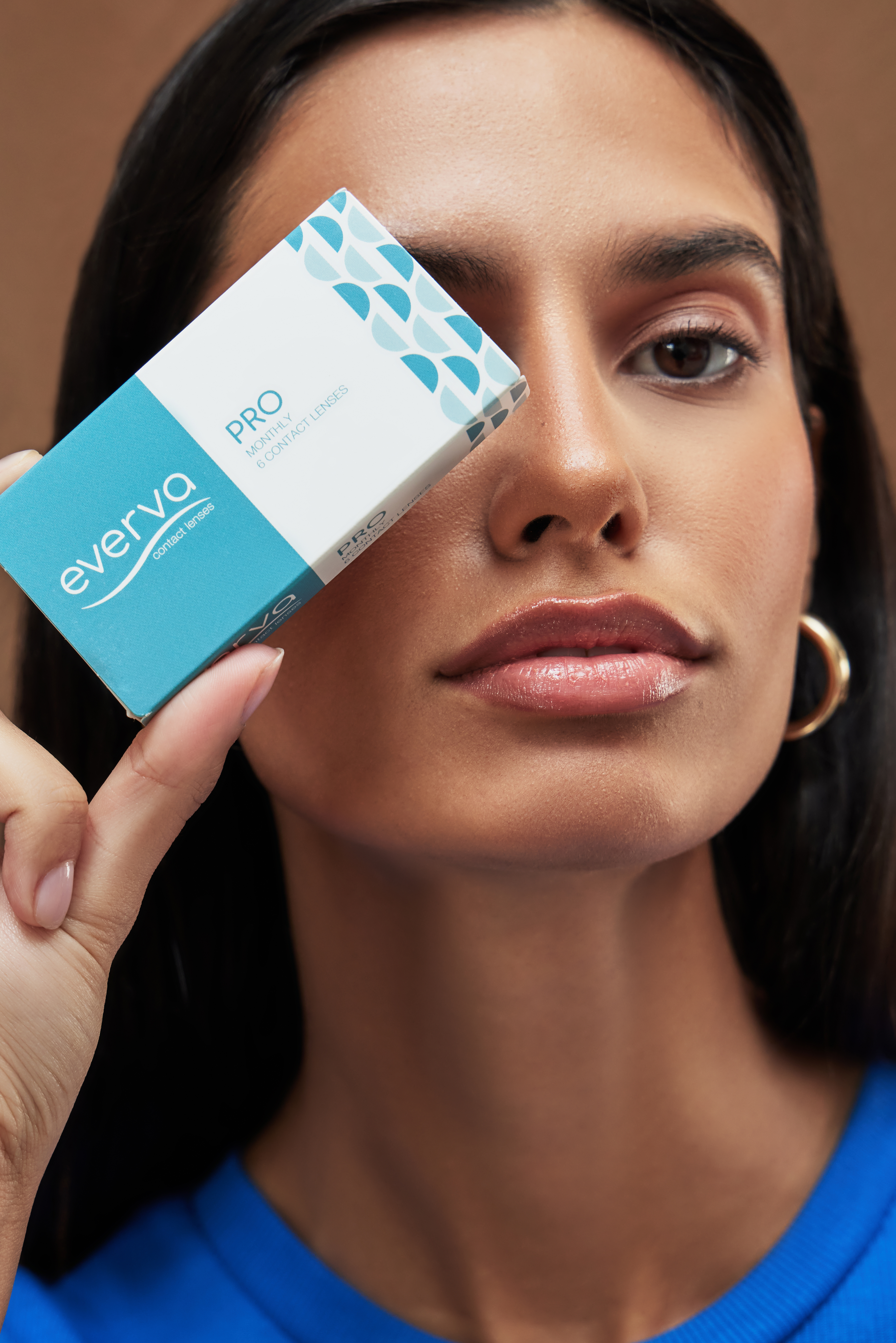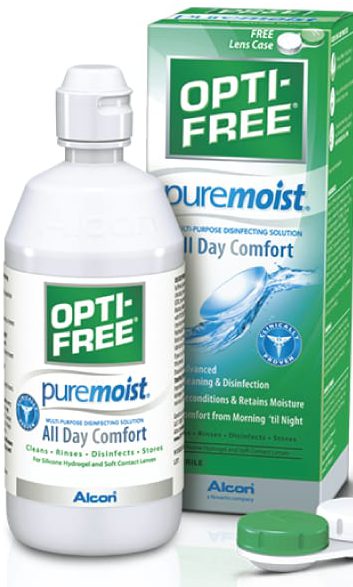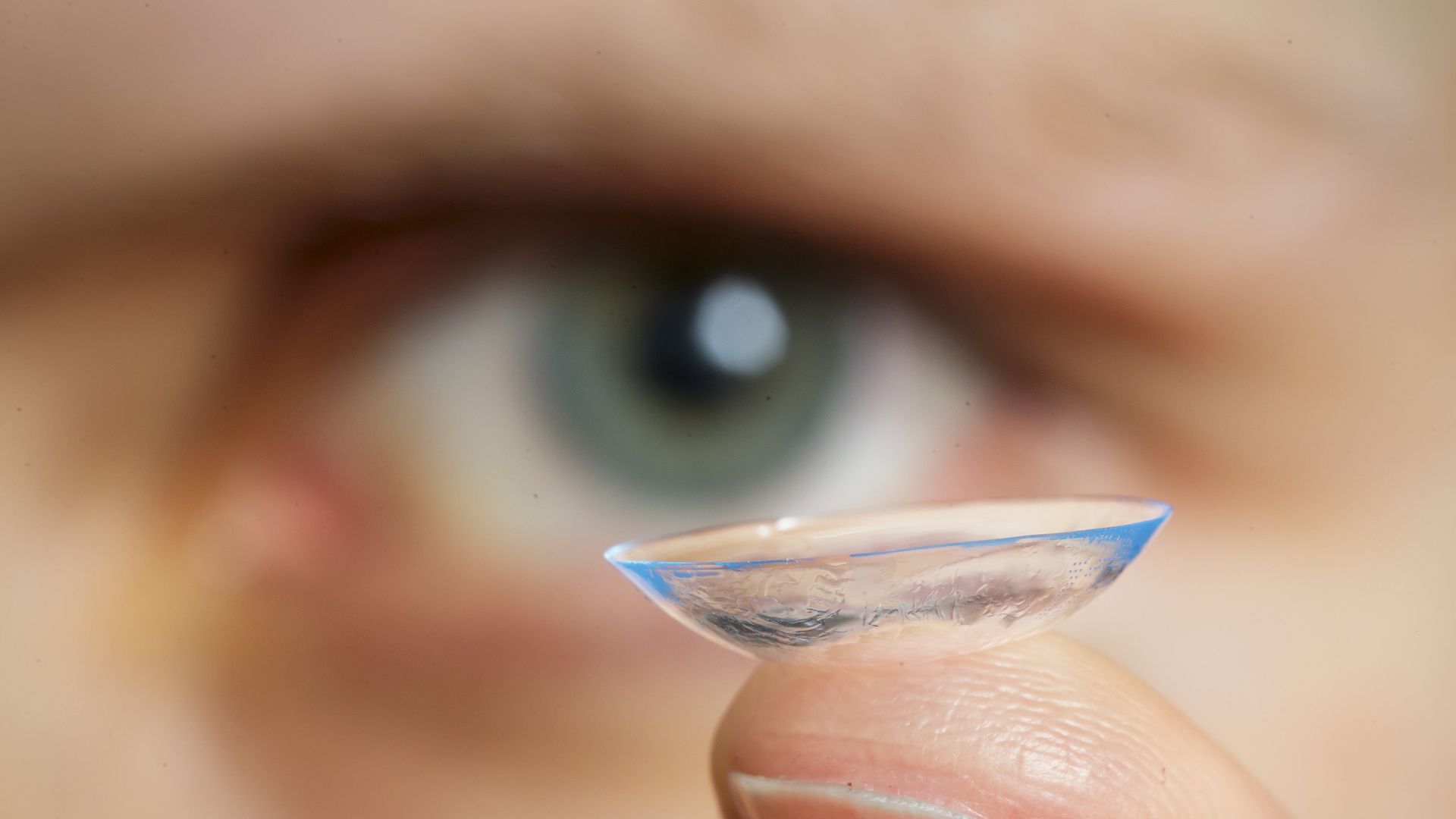Contact lenses are a great choice for almost anyone who needs vision correction but does not want to wear glasses all the time or is not willing to undergo surgery for vision correction. Most of us often find it quite hard to understand our own contact lens prescription. We keep going to our doctor at regular follow-ups, get a new prescription but don’t pay much attention to what’s written on it. But have you ever wondered what all those numbers really mean? Your contact lens prescription has various abbreviations, values and terms that may seem confusing and look incomprehensible, but once you understand what each term indicates, understanding your prescription would seem quite easy.
First of all, it is vital to know that the prescription for contact lenses is completely different from the prescription for glasses, even though they may be issued together. So, even if you already have a prescription for your glasses, you will still be needing a contact lenses prescription before you start using them. This is because the glasses are placed almost 12 millimetres from your eyes, while as the contact lenses are placed directly on the surface of the eyes. So, if you want to wear both contact lenses and eyeglasses, you will need two separate prescriptions.
Decoding the Contact Lens Prescription
Here are some contact lens prescription basics that can come handy:
OD/OS: These are the terms used for right eye and left eye. They are derived from Latin words- Oculus dexter (OD) for “right eye” and oculus sinister (OS) for the “left eye”. They indicate the strength of lens that is prescribed for each eye.
OU: This is an abbreviation for another Latin term called Oculus uterque, which means “both eyes”. So, if both of your eyes need lenses of the same strength, your doctor may use the term OU instead of OD and OS.
Power (PWR), Sphere (SPH): this number indicates the strength of correction which is needed for that particular eye. If there is a (+) sign before the number, it means hyperopia or far-sightedness. a (-) sign indicates short-sightedness or myopia. If your eye does not need a correction, then you may see the sign PL, or plano, which indicates that the strength required is 0.
The power of the lens is measured in diopters (D), and for this reason lens manufacturers create contact lenses in 0.25 D increments (such as e.g. -4.00 D, -4.25 D, -4.50 D, -4.75 D). The farther away your number is from 0, the stronger is your power prescription.
Base Curve or BC: this is a number which indicates how curved the inside of your lens is. This number usually ranges from 8-10 and it ensures that the lens sits well against the curvature of your eye, thereby making it comfortable. A lower base curve number indicates a steeper curve, and a higher base curve number indicates means a flatter curve.
Diameter or DIA: this number denotes the width of the contact lens from one edge to the other. It is denoted in millimetres and this number ensures that your lens will cover your eye properly.
Brand: your doctor may prescribe you a specific type/brand of contact lens. Since different brands use different materials and may have specific unique features, your doctor will prescribe a type that is best suited for your eyes.
Cylinder or CYL: for those people who have astigmatism, one more value is added to the contact lens prescription for cylindrical lens. It indicates the strength that the lens needs to correct for the astigmatism.
Axis or X: the axis or X is used for astigmatism and it is a value that indicates where in the lens the astigmatism correction should be located.
Add Power or ADD: for people who need contact lenses that have bifocals in them, they will require an additional measurement known as Add power or ADD. This indicates the strength of power that the lens needs to obtain clear vision at close range.
TYPES OF CONTACT LENSES
Here are some basics about contact lenses that you should know if you are interested in wearing contact lenses:
1. The material of Contact Lens
The first and foremost feature that comes to mind while choosing contact lenses is the material that suits your needs the most. On the basis of the material, there are broadly 5 types of contact lenses:
- Soft lenses: These lenses are designed from soft, gel like plastics known as hydrogels. Hydrogel is a water containing plastic material. Soft lenses are extremely thin, pliable and sit smoothly over the front surface of the eye.
- Silicone hydrogel lenses:These lenses are made from an advanced version of the soft lens material that helps more oxygen to pass through the lens surface and reach the eye. Currently, silicone-hydrogel lenses are the most popular type of contact lenses.
- Rigid Gas permeable/ Gas Permeable lenses: Also called GP or RGP lenses, these contact lenses retain their shape on the eye and are rigid in nature. This makes them extremely useful for correcting astigmatism and other refractive errors. Typically, the gas permeable lenses are smaller in diameter than the soft lenses and are composed of materials that are highly oxygen permeable. Being rigid, it usually takes some time for the eyes to adjust to these lenses when you first start using them. Once the eyes get adapted to the material, most people who use GP lenses find them to be as comfortable and hassle free as the soft lenses.
- Hybrid contact lenses: As suggested by their name, these lenses have a central zone made from rigid gas permeable material and a peripheral zone made from hydrogel or silicone hydrogel material. This design is created to provide the comfort of silicone hydrogel or soft lenses and at the same time provide crystal clear optics of the RGP or GP lenses.
- PMMA lenses (PolyMethyl MethAcrylate): These are the lenses that are designed from a rigid plastic material that is not oxygen permeable, making them look like from GP rigid contact lens. PMMA lenses were quite common several years ago, but they have now been replaced by the GP lenses.
| Lens Material | Features |
| Soft lenses | Designed from soft, gel like plastics known as hydrogels. Extremely thin, pliable and sit smoothly over the eye. |
| Silicone hydrogel lenses | Made from a material that lets oxygen pass through and reach the eye. Very comfortable, most popular type of contact lenses. |
| Rigid Gas permeable/ Gas Permeable lenses | Retain their shape on the eye and are rigid in nature. Correct astigmatism and other refractive errors. Smaller in diameter than soft lenses and highly oxygen permeable. People who use GP lenses find them as comfortable and as the soft lenses. |
| Hybrid contact lenses | Have a central zone made from rigid gas permeable material and a peripheral zone made from hydrogel or silicone hydrogel material.
Provide comfort of silicone hydrogel or soft lenses and and crystal clear optics of the RGP or GP lenses. |
| PMMA lenses | Designed from a rigid plastic material that is not oxygen permeable, making them look like GP rigid contact lens. They have now been largely replaced by the GP lenses. |
2. Wearing time of the contact lens
On the basis of the wearing time, contact lenses are broadly divided into two categories :
- Daily wear contact lenses: these are the contact lenses that can be used only once and should be removed before going to sleep.
- Extended wear contact lenses: these are the lenses that could be used for a limited number of days and can be worn overnight. Sometimes the term continuous wear contact lenses is used for extended wear lenses that can be worn for up to 30 days.
3. Frequency of replacement
The contact lenses need to be replaced frequently in order to prevent contamination, avoid build up of lens deposits and reduce risk of infections.
Based on how frequently they should be discarded, soft lenses have these general classifications:
| Types of Lenses | Frequency of Replacement |
| Daily disposable lenses | These need to be discarded every day. |
| Disposable lenses | These need to be discarded after every 2 weeks or earlier. |
| Frequent replacement lenses | These need to be discarded every month or quarterly. Discard monthly or quarterly. |
| Traditional (reusable) lenses | These usually need to be discarded twice a year. |
The GP/RGP lenses do not need to be discarded as often as the soft lenses as they are more resistant to lens build up. Typically, GP lenses can be used for a year before replacing them.
4. Design of contact lens
Both silicone hydrogel and hydrogel contact lenses are available in a huge variety of designs such, depending on the need. Here are the most common designs:
- Spherical contact lenses these are the lenses that have the same power across the entire optical part of the lens to correct the refractive error.
- Toric soft contact lenses these contact lenses have different power along different meridians of the contact lens so as to correct astigmatism in addition to correcting myopia/hyperopia.

- Bifocal contact lenses with age, a person’s ability to focus from far to near reduces. This condition is known as presbyopia. So, if a person has difficulty with both near and far vision, he/she needs bifocal lenses. These lenses have the power for both the near and far vision in one lens. They are available in the form of gas permeable and soft lenses.
- Multifocal contact lenses these are the lenses that have different zones of power for near and far vision to correct presbyopia along with myopia/hyperopia. Sometimes, multifocal lenses may be prescribed to correct astigmatism.
- Cosmetic contact lenses these contact lenses are used for cosmetic purposes with the intention of intensifying or changing the colour of the eyes.
5. Contact lens with advanced features
Certain conditions of the eyes require contact lenses with more advanced features. These include:
- Contact lenses for dry eye: In some people, contact lenses can cause the eyes to dry out. This is known as contact lens-induced dry eyes (CLIDE) and this occurs because the thin layer of contact lens material blocks out oxygen flow to the eyes. When there is inadequate supply of oxygen, the eyes find it hard to develop natural tears, leading to dry eyes. There are contact lenses that are specifically designed to allow more oxygen to reach the eye, thereby reducing the impact of CLIDE. The commonly prescribed contact lenses for dry eyes include daily disposable contact lenses, silicone hydrogel contact lenses and low water contact lenses. Daily disposable contact lenses reduce the risk of discomfort due to build up of dirt deposits as they are discarded at the end of the day. Silicone hydrogel lenses are extremely comfortable to wear and they pass up to 5 times more oxygen to the eyes as compared to the hydrogel lenses. Most people think that contact lenses with high water content are better for dry eyes. However, that is not the case. Contact lenses with a high water content tend to draw out the eye’s natural tears as well leading to dry eyes. Also, lenses with high water content can become more dehydrated. So, people with dry eyes may be prescribed contact lenses with a relatively low water content.
- Prosthetic Lenses: These lenses are specially designed for people in whom the eye has been disfigured due to an injury or a disease. These lenses are opaque soft lenses that mask the disfigurement and are custom made so as to match the appearance and features of the other, unaffected eye.
- Custom lenses: For some people, the conventional contact lenses do not work and they need made-to-order contact lenses that are specifically designed for the individual eye size, shape and visual requirements. These lenses are called custom lenses.
- UV-inhibiting lenses: There are some soft contact lenses that help in protecting the eyes from the harmful ultraviolet rays of the shun, which can lead to various eye problems such as cataract. However, since the contact lenses do not cover the entire eye, it is advisable to still wear UV-blocking sunglasses when stepping outdoors, if you want the best possible protection from the sun.
- Scleral lenses: Scleral lenses are large diameter, gas permeable lenses that are specifically designed to treat irregularities in the cornea such as keratoconus and presbyopia. These lenses are designed so that they vault over the entire corneal area and they sit on the white part of the eye, known as the sclera. In this way, the scleral lenses replace the irregular cornea with a smooth and perfect corneal surface free of irregularities to correct visual problems that are caused by corneal irregularities such as keratoconus. Another interesting feature of the scleral lens is that the space between the back surface of the scleral lens and the cornea acts as a fluid reservoir which provides comfort to those individuals who have severe dry eyes and are otherwise unable to wear contact lenses.
Coloured Contact Lenses
Ideally, the colour of contact lenses should have no effect on your vision. However, it is always best to obtain a prescription for them so that your doctor prescribes the ones that fit your eyes properly. Following are the commonly available types of coloured contact lenses:
Visibility tinted lenses – these are the type of coloured lenses that have a slightly tinted colour, (mostly blue) which helps you to see them while you are handling the lens when it is in its case.
Enhancer lenses – Enhancer lenses are those lenses that have a medium tint to accentuate or enhance the natural colour of your eyes.
Opaque lenses – these are the lenses that are made from a solid ring of colour around the iris and they mask the natural colour of your eyes. These lenses will mask your natural eye colour. They are made with a solid ring of colour around the iris and a clear circle in the middle so you can see. Opaque lenses available in a wide range of colours.
CONTACT LENSES FOR ASTIGMATISM
Astigmatism is a common vision condition which causes blurry vision. This happens when the front cover of the eye, known as the cornea, is shaped irregularly due to the curvature of the lens inside the eye. This irregularly shaped cornea then prevents the light from getting focussed properly on to the retina (the back of the eye). As a result, the vision becomes blurry. This can also cause headaches and eye discomfort.
Astigmatism usually occurs along with other refractive errors such as near-sightedness (myopia) and far-sightedness (hyperopia). The exact cause of astigmatism is not known, however, there are many factors that can increase the risk, such as a family history of astigmatism.
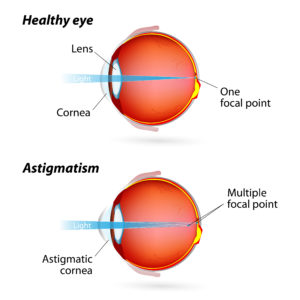
Usually, people with astigmatism believe that contact lenses are not an option for them. However, such is not the case. There are various options for contact lens available for correcting astigmatism effectively. Here are the most commonly available contact lens options for correcting astigmatism:
1.Toric contact lenses (soft): Toric contact lenses are soft contact lenses that are designed to correct astigmatism. Toric lenses are designed either from the conventional hydrogel material or from silicone hydrogel material, which is highly breathable. Toric contact lenses differ from the spherical soft contact lens in two essential ways-
Firstly, toric lenses have different powers along different meridians of the lens which helps in correcting the varying amount of far-sightedness or near-sightedness along the different meridians of the eye, a feature that is characteristic for astigmatism.
Secondly, toric lenses are designed in such a way that enables the lens to rotate along a proper orientation on the cornea. This helps the power meridians of the lens to align with the respective meridians on the eye for crystal clear vision.
2.Gas permeable contact lenses: Rigid gas permeable contact lenses (RGP or GP lenses) are also commonly prescribed for astigmatism correction. Usually, the GP lenses can correct astigmatism without the need for toric design. This is because they are rigid and retain their shape on the eye, instead of conforming to the irregular shape of the cornea of the eye with contact lenses. However, sometimes for unusual types of astigmatism, GP lenses are designed that have toric design feature as well. Usually, people with astigmatism notice a sharper vision with GP contact lenses than with toric lenses. However, since GP contacts are thicker and rigid in nature, these lenses typically take more time to adapt to.
3.Scleral Lenses: In some people with astigmatism, large diameter gas permeable lenses called scleral lenses may be prescribed. This is usually required for people with highly irregular corneal surface.
4.Hybrid contact lenses: Hybrid lenses work very well for some people with astigmatism. They have a central rigid zone made from GP lens material, and a peripheral zone made from soft hydrogel or silicone hydrogel material. Once fitted successfully, hybrid contact lenses provide benefits of both types of contact lenses for astigmatism — the sharp crystal clear vision of GP lenses and the comfort which is comparable to wearing toric soft lenses.
5.Bifocal contacts for astigmatism: These are the soft contact lenses specially designed to correct both astigmatism and presbyopia. These ensure that a person with astigmatism can remain glass free even after the age of 40.
WEARING YOUR CONTACT LENSES
Before applying your contact lenses, make it a point to always wash your hands thoroughly. Avoid using scented soaps and soaps containing lanolin and other moisturizing agents as these can get adhered to your lens.
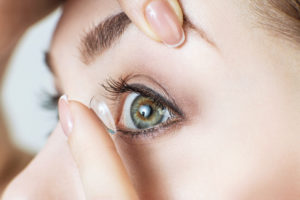
Make it a bit, to begin with the same eye every time. This way you can avoid mixing up which lens goes on which eye. Here are some essential steps that you should follow while applying your contact lenses:
- Shake the lens case gently to ensure that the lens loosens. Never pull the lens with your finger as doing so might damage it.
- Carefully slide the lens out from its case and into the palm of your hand. Rinse your contact lens with the contact lens solution.
- Place the lens on the tip of your middle or index finger. Make sure your finger is dry.
- Using the thumb and fingers of the other hand, pull your upper eyelid upwards and your lower eyelid downwards at the same time.
- Maintain your gaze upward or forward and position the lens on your eye.
- Close your eyes slowly and roll your eyes in a full circle. This will help the lens to settle. To ensure that your lens is well centred on the eye, take a close look in the mirror. If centred correctly, your eye should feel comfortable and your vision should be clear.
REMOVING YOUR CONTACT LENSES.
Make sure your hands are clean before taking off your contact lenses.
For soft contact lenses, look sideways or upward while gently pulling down the contact lens on the lower eyelid. Using your finger, carefully move the lens towards the white of the eye. Then you can gently pinch the lens together using thumb and index finger and take if off. Make it a point to keep your fingernails short until you have mastered contact lens removal. This will prevent scratching or damaging your eye.
To remove GP lenses, open your eyes wide open. Using the finger of the other hand, pull the skin outside the lateral aspect of your eye (area between your upper and lower eyelid). Pull it outwards towards your ear keeping your eye wide open. Your lens should pop out easily into the palm of your hand. Alternatively, you can use a silicone device specifically designed for removing GP lenses.
EYE MAKEUP AND CONTACT LENSES
Wearing your eye makeup on and taking it off can be somewhat annoying when you first start wearing contact lenses. Here are some important tips that you can follow:
- Make it a habit to always put your contact lenses on and them apply the makeup.
- Use non-allergenic makeup only.
- Keep your eye closed while applying eye makeup.
- Brush off any excess eyeshadow powder before opening your eye.
- Before removing your makeup, wash and dry your hands.
- First, remove your contact lenses carefully without bumping them into any makeup.
- Once you have removed your contact lenses, use your makeup remover to take your makeup off.
- Make sure that you replace your eye makeup frequently and do not share your makeup brush and other products with others.
THINGS TO KEEP IN MIND WHEN USING CONTACT LENSES:
- Make sure you always wash your hands and dry them thoroughly before you handle your contact lenses.
- Make it a habit to regularly and carefully clean your contact lenses as suggested by your optometrist/ophthalmologist.
- Always store your lenses in the lens storage case. Remember to replace the case after every three months. After each use, clean the case and let it dry in between cleanings.
- Always use fresh solution to store and clean the contact lenses. Make it a point to discard the solution as per the recommendations of the manufacturer.
- Follow the contact lens replacement schedule strictly as recommended by your optometrist/ophthalmologist.
- Remove your contact lenses before entering a hot tub or before swimming.
- Never use cream soaps when handling the contact lenses as they may leave a soap film that can get transferred to the lens or lens cases.
- Never use home-made saline solutions for cleaning your lenses. They can lead to a serious and potentially blinding condition in people who use soft contact lenses.
- Do not use tap water for cleaning the lenses. Never share your contacts with others and most importantly, never sleep with your lenses on.
- If your soft contact lens gets stuck in the eye, wash your hands and then try to determine the exact location of the lens. If the lens is centred around the eye, it means that the lens has dried out. In this case, lubricate the eye with sterile saline, contact lens solution or re-wetting solution. Then close your eye and massage the upper lid gently till you can feel the lens move. Keep lubricating till you can feel the lens move freely. Once it does, remove the lens like you normally would. If your eye feels dry or irritated after removing the lens, lubricate your eye with lubricating eye drops. If irritation persists, consult a doctor immediately.
- If a GP contact lens gets stuck in the eye, then avoid massaging the eyelid. Instead, gently press your eye just outside the edge of the lens using the pad of the fingertip. This will break the suction that is keeping the contact lens stuck to the eye. If this technique fails, consult your doctor immediately to get the lens removed at the earliest.

